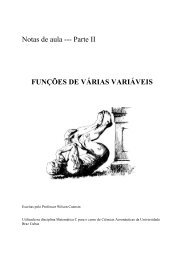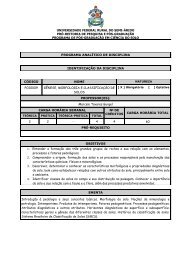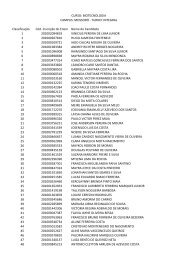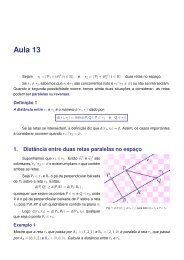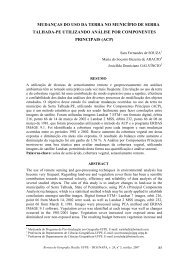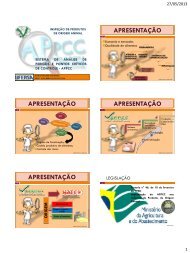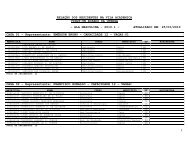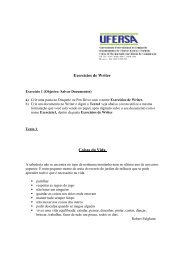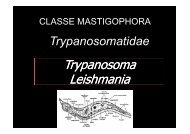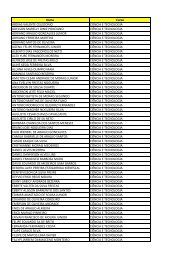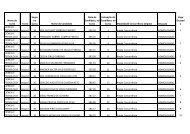Injectable Anesthesia and Analgesia of Birds by J. Paul ... - Ufersa
Injectable Anesthesia and Analgesia of Birds by J. Paul ... - Ufersa
Injectable Anesthesia and Analgesia of Birds by J. Paul ... - Ufersa
You also want an ePaper? Increase the reach of your titles
YUMPU automatically turns print PDFs into web optimized ePapers that Google loves.
as to avoid the bird recovering under the effects <strong>of</strong> ketamine alone as this can result in a rough recovery.<br />
Alpha 2<br />
-adrenergic agonist drugs are not recommended as single anesthetic or immobilization agents for birds. In pigeons <strong>and</strong><br />
Amazon parrots, high doses <strong>of</strong> medetomidine had a sedative effect but did not immobilize the birds [18]. Xylazine<br />
administered alone causes respiratory depression, excitation, convulsions <strong>and</strong> prolonged recovery [12]. All alpha 2<br />
-adrenergic<br />
agonists have pr<strong>of</strong>ound cardiopulmonary effects. Xylazine <strong>and</strong> medetomidine cause decreases in HR, RR, blood pH,<br />
hypoxemia, <strong>and</strong> hypercarbia [4,12,14,18]. The arrythmogenic effects <strong>of</strong> the alpha 2<br />
-adrenergic agonists can lead to<br />
cardiovascular instability <strong>and</strong>, when coupled with hypoventilation <strong>and</strong> hypercarbia, can have an irreversible, fatal effect.<br />
Alpha 2<br />
-adrenergic agonist drugs are a poor choice <strong>of</strong> anesthetic, alone or in combination, when a bird is highly stressed.<br />
General excitement can effectively over-ride the sedative effects <strong>of</strong> alpha 2<br />
-adrenergic agonists, although the mechanism for<br />
this effect is not clear. Therefore, when using alpha 2<br />
-adrenergic agonist drugs, approach the bird quietly, inject the drug <strong>and</strong><br />
place the bird back into a familiar, quiet <strong>and</strong> dimly lit enclosure while waiting for the drug to take effect. The induction<br />
period is 5 - 10 min, depending on dose <strong>and</strong> size <strong>of</strong> the bird. Ratites, raptors <strong>and</strong> long-billed birds can have a hood placed<br />
over the head for calming when a dark cage is not available.<br />
Xylazine plus ketamine combinations have been evaluated in several avian species. Blood pressure becomes elevated, heart<br />
rate is decreased, <strong>and</strong> hypoxemia, hypoventilation, <strong>and</strong> hypercapnia occur [19-20].<br />
An anesthetic combination consisting <strong>of</strong> medetomidine, midazolam <strong>and</strong> ketamine was evaluated <strong>and</strong> found to be unsafe for<br />
use in ducks [21] as it caused bradycardia, primarily attributed to the medetomidine [21,22]. Medetomidine also decreases<br />
respiratory rate. Apnea followed <strong>by</strong> a fatal decrease in heart rate <strong>and</strong> blood pressure was documented in four <strong>of</strong> twelve ducks<br />
receiving medetomidine [21]. Atipamezole <strong>and</strong> flumazenil were given intravenously to reverse medetomidine <strong>and</strong><br />
midazolam, respectively, <strong>and</strong> the ducks rapidly regained consciousness <strong>and</strong> voluntary movement [21].<br />
Prop<strong>of</strong>ol<br />
Prop<strong>of</strong>ol is an intravenously administered anesthetic with rapid onset, smooth induction, short duration <strong>of</strong> effect, <strong>and</strong> smooth,<br />
rapid recovery. Intravenous catheters are highly recommended for its administration because the drug must be given slowly<br />
for induction <strong>and</strong> <strong>of</strong>ten given repeatedly to maintain anesthesia. A maximum <strong>of</strong> 2 mg/kg bolus every 30 seconds is<br />
recommended for induction, after which 0.5 - 1.0 mg/kg/min is used to maintain surgical anesthesia [1,23]. In a study using<br />
ducks, prop<strong>of</strong>ol was given as an initial IV bolus <strong>and</strong> was constantly bolused at 1 - 4 mg/kg every 5 min to maintain a light<br />
plane <strong>of</strong> anesthesia [21]. In studies that monitored cardiopulmonary responses to prop<strong>of</strong>ol, mean arterial pressure (MAP)<br />
decreased significantly [1,23]. A short period <strong>of</strong> apnea following induction is a consistent finding [21,22,24] <strong>and</strong> respiratory<br />
depression can occur during induction <strong>and</strong> maintenance with prop<strong>of</strong>ol [23, 24]. Cardiac arrhythmias including ventricular<br />
premature contractions <strong>and</strong> ventricular tachycardia, were common in chickens <strong>and</strong> pr<strong>of</strong>ound bradycardia was noted in ducks<br />
after the initial bolus <strong>of</strong> prop<strong>of</strong>ol [21,23]. Prop<strong>of</strong>ol has a narrow margin <strong>of</strong> safety in birds <strong>and</strong> supplemental oxygen <strong>and</strong><br />
respiratory assistance must be provided to counteract apnea, hypoventilation <strong>and</strong> hypoxemia [21,23-25].<br />
Anticholinergics<br />
The use <strong>of</strong> anticholinergics for birds is controversial. Indeed, atropine <strong>and</strong> glycopyrrolate are effective for the treatment <strong>of</strong><br />
vagally induced bradycardia [26]. Some argue, however, that they cause respiratory secretions to become more viscous <strong>and</strong><br />
thus more likely to plug narrow endotracheal tubes [27]. Others [28] recommend anticholinergics for their ability to reduce<br />
respiratory mucus production <strong>and</strong> prevent formation <strong>of</strong> mucus plugs in small endotracheal tubes [4]. The oculocardiac reflex<br />
has been reported in a cockatiel <strong>and</strong> suggests that treatment with an anticholinergic prior to or during ocular surgery may<br />
prevent this reflex which is thought to be caused <strong>by</strong> ocular manipulation resulting in cardiac dysrhythmias [29].<br />
Ratites (Ostriches, Emus, Cassowaries <strong>and</strong> Rheas)<br />
In these large birds, injectable anesthetics are frequently used for short procedures <strong>and</strong> for induction <strong>of</strong> anesthesia prior to<br />
inhalation anesthesia. Several reports have been written on anesthetic protocols for ratites <strong>and</strong> a recent review compared the<br />
most common protocols [22,30-35]. These bird, when healthy, are too strong <strong>and</strong> unpredictable for simple mask induction<br />
with inhaled anesthetics. Intravenous injections can be given in the jugular vein or brachial vein, although the emu’s brachial<br />
vein is small <strong>and</strong> difficult to access. Placing a catheter in the jugular, brachial, or medial metatarsal vein will facilitate IV<br />
injection <strong>and</strong> induction. <strong>Injectable</strong> anesthetics most commonly used for ratites include combinations <strong>of</strong> Alpha 2<br />
-adrenergic<br />
agonists followed <strong>by</strong> ketamine, or a benzodiazepine followed <strong>by</strong> ketamine, tiletamine-zolazepam, carfentanil or etorphine<br />
[28,34]. Benzodiazepines given prior to induction help produce smooth inductions <strong>and</strong> smooth but slow recoveries. Induction<br />
with tiletamine/zolazepam is excellent <strong>and</strong> rapid, although when given IV, violent recoveries have been reported [30,34].<br />
Benzodiazepines given with tiletamine-zolazepam will smooth recovery [30]. Induction with xylazine-ketamine is adequate,<br />
but recovery can be difficult [34]. Carfentanil is not recommended due to an excitatory response even when used with<br />
xylazine [34]. When etorphine was combined with medetomidine, recumbency occurred rapidly, birds were sedate <strong>and</strong><br />
muscle relaxation was adequate [33]. Other etorphine combinations, when given to free-ranging ostriches, caused initial



